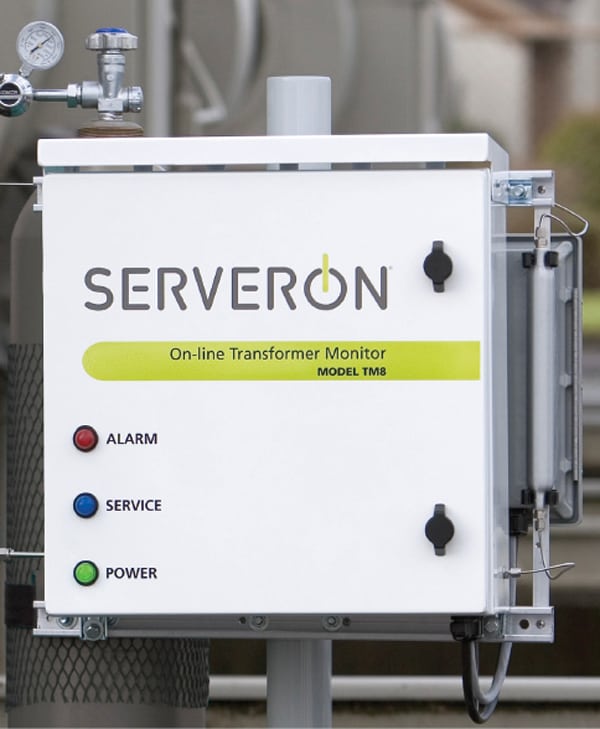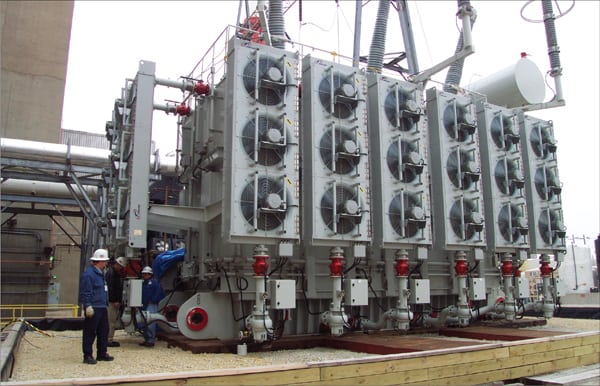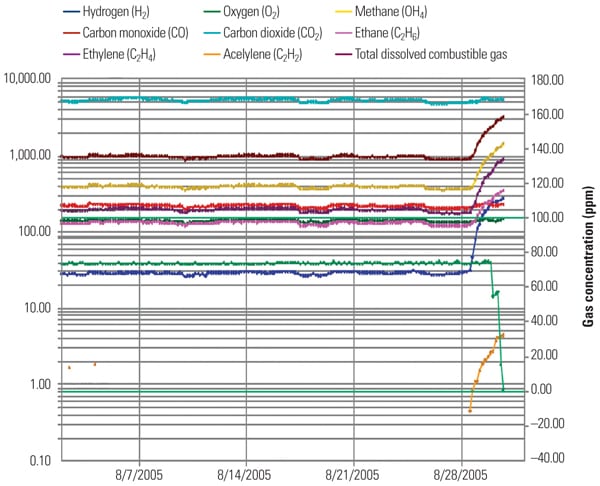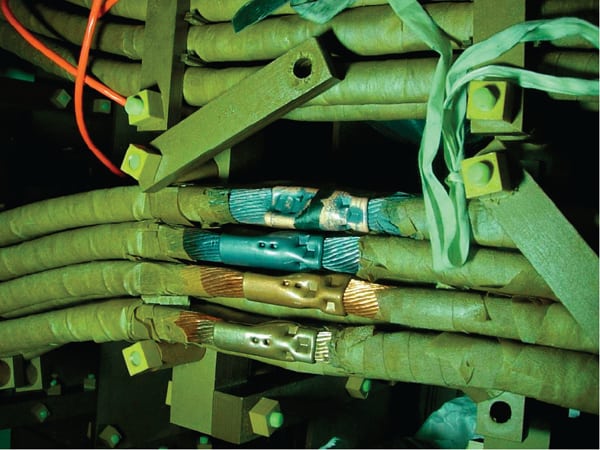Exelon Enjoys Benefits of Online Transformer Monitoring
As large electrical transformers age, their internal structure can break down, creating hazardous conditions. One of the most dangerous is the buildup of combustible gases in transformer cooling oil that is caused by the degradation of insulating materials around coil windings and leads. Therefore, analyzing the oil to look for dissolved gas is critical to preventing aging transformer fleets from having catastrophic failures.
Remote online monitoring of dissolved gases in transformer cooling oil has been done for more than a decade, and its usage by utilities has grown significantly since the early days. That practice has accelerated as stories have been published showing the effectiveness of the new monitoring technologies. One of the lessons learned by this experience is that the old industry practice of performing periodic off-site laboratory analysis of transformer oil may miss the warning signs of transformer failure, which can materialize, subside, and emerge again over a matter of days or even hours. It’s not the methodology of the labs that is at fault but the frequency of sampling. Utilities are learning that in order to protect against many types of failures within their transformers, they must take multiple readings daily, using equipment that has been designed to replicate the precise lab tests on site.
One of the utilities that has pioneered the use of online monitoring is Exelon Corp. of Chicago, Ill. Exelon has had experience using different online monitoring technologies since the early 2000s, starting with units that monitor dissolved hydrogen only. Exelon has supplemented these with units that look for traces of eight different gases, emulating full-blown laboratory analyses. The newer units have been instrumental in helping the company identify specific failure modes on several occasions, allowing it to protect against catastrophic events.
The most popular laboratory analysis method for measuring dissolved gases is gas chromatography. In this process, gases are separated from tiny samples of transformer oil into components corresponding to their chemical proportions in the oil. Typically, labs follow the process outlined in IEEE Standard C57.104 to look for the presence of eight specific gases: hydrogen, oxygen, methane, carbon dioxide, carbon monoxide, ethylene, ethane, and acetylene. This is exactly the process that one vendor of remote online transformer monitoring systems uses to obtain its results. The Serveron Model TM8 online monitor from BPL Global (Figure 1) is the only online monitor that uses gas chromatography to detect these eight different gases while also providing a nitrogen measurement.
 |
| 1. Sniffing transformer gases. The Serveron TM8 online transformer monitors use gas chromatography to detect eight gases in transformer oil. Courtesy: Exelon Corp. |
Online Monitoring Averts Danger
Eight-gas monitoring enabled Exelon to avoid what could have been a costly transformer failure at its Dresden 2 nuclear power plant in northern Illinois. The company first installed an 1,100 MVA 345/17.1 kV three-phase transformer at the site in November 2003 (Figure 2). The transformer was instrumented with an online hydrogen monitor and also an eight-gas monitor as a test to compare the results from both monitoring systems over time.
 |
| 2. Heavy lift. The main power transformer at Exelon’s Dresden 2 nuclear power plant. Courtesy: Exelon Corp. |
On August 28, 2005, the hydrogen monitor recorded an increase from 55 ppm to 75 ppm, signaling to operations personnel that there could be a dangerous situation materializing inside the transformer. To learn more about what was going on, an Exelon system engineer accessed the data from the eight-gas monitor remotely and determined that “hot metal” gases (methane, ethane, ethylene, and acetylene) were increasing inside the transformer, but little carbon monoxide was present, suggesting that leads or windings may be overheating but that the insulation was not involved. The plot of the gas levels is shown in Figure 3.
 |
| 3. Continuous monitoring. The concentrations of important dissolved gases are continuously monitored in Exelon’s Dresden 2 transformer. The event on August 28, 2005, is clearly visible at the right of the plot. Courtesy: Exelon Corp. |
After the Dresden unit was monitored overnight and the data showed continuously increasing gases, maintenance personnel tried decreasing the load but saw no change in gassing rate. The unit was subsequently taken off-line. Inspection revealed that several low-voltage cable conductors had varying degrees of damage and one was burned through (Figure 4). Apparently, it was the burn-through event on August 28 that caused the high rate of gassing.
 |
| 4. Detecting damage. Damaged cable connectors at the Exelon Dresden 2 plant resulted in increased levels of flammable gas in the transformer oil. Courtesy: Exelon Corp. |
Ultimately, the Dresden unit was replaced by a new 952 MVA transformer, which itself had a problem that was caught by online monitoring. As the weather changed from mid-winter conditions to 75F to 80F in the spring of 2006, the gas monitor detected increases in several of the flammable gases. Upon close inspection, it was determined in this case that the problem was being caused by insufficient cooling of the transformer oil. The situation was rectified as soon as Exelon turned on additional coolers in the transformer.
Positive Online Monitoring Results
Subsequent to the events at Dresden, an event occurred in January 2009 at Exelon’s Peach Bottom nuclear power plant in Pennsylvania that resulted in an increase in the total dissolved combustible gases in one of the plant’s main power transformers from 1,800 ppm to above 2,600 ppm in a 24-hour period, including an increase in acetylene that had never been recorded before. A 75% load reduction resulted in no significant change to the elevated levels of combustible gas.
This event was preceded by a slow upward trend in the concentration of hot metal gas (on average 10 ppm/day, primarily ethylene) in the 36-year-old single-phase 390 MVA unit that had caused the utility to schedule a replacement of the unit in fall 2009. Because of the January event, the transformer was taken offline and replaced with an on-site spare, avoiding what could have been a catastrophic transformer failure plus an associated reactor scram and many weeks of lost generation.
Online dissolved gas monitoring is proving its value in other Exelon plants as well. Besides Dresden and Peach Bottom, Exelon has used online monitoring at its Limerick, Pennsylvania, reactor plant. Recently, an eight-gas monitor was set up at the plant to take hourly measurements in order to monitor an aging generation step-up (GSU) transformer. Plant personnel can now monitor the load and gassing response of their GSU in order to ensure that it remains within specified limits.
The Power Industry Is on the Bandwagon
In all of these cases, frequent oil analysis monitoring and preestablished action plans were able to allow for transformer replacement before the occurrence of a catastrophic failure. Exelon’s experience, as well as that of other power utilities across the grid, has spawned a report by the Institute of Nuclear Power Operations (INPO) of Atlanta, Georgia, that recommends that performance monitoring and trending be applied to all large transformers in order to establish a baseline for transformer maintenance strategies.
In the case of dissolved gas monitoring, INPO recommends that online continuous monitoring be used. That conclusion has been echoed by the Electric Power Research Institute, which has been funding research on online transformer monitoring since the early 1990s.
Extending Exelon’s Online Monitoring Programs
Exelon’s positive experience with online transformer oil monitoring has caused the company to make remote online monitoring one of the main foundations of its maintenance effort, and the company has begun to explore the monitoring of its other distribution assets. For example, the company has begun installing online monitors on its transformer bushings that will take measurements and be able to detect the presence of dangerous conditions without first requiring that the system be taken offline.
These experiences at Exelon show that online monitoring enables improvements in reliability and safety and has a proven return on investment as well.
—Contributed by Ismael Rivera, transformer and switchyard system manager for Exelon Corp.